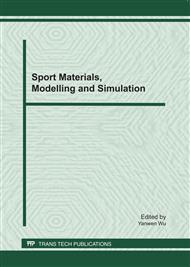[1]
X. Fan, P. C. Chen, and J. Yen, Learning HMM-based cognitive load models for supporting human-agent teamwork, Cognitive Systems Research, vol. 11, 2010, p.108–119.
DOI: 10.1016/j.cogsys.2008.08.004
Google Scholar
[2]
F. Amadieu, C. Mariné, and C. Laimay, The attention-guiding effect and cognitive load in the comprehension of animations, Computers in Human Behavior, 2010, doi: 10. 1016/j. chb. 2010. 05. 009.
DOI: 10.1016/j.chb.2010.05.009
Google Scholar
[3]
E. Macaluso, Orienting of spatial attention and the interplay between the senses, Cotex, vol. 46, 2010, p.282–297.
DOI: 10.1016/j.cortex.2009.05.010
Google Scholar
[4]
T. Bachmann, and C. Murd, Covert spatial attention in search for the location of a color-afterimage patch speeds up its decay from awareness: Introducing a method useful for the study of neural correlates of visual awareness, Vision Research, vol. 50, 2010, p.1048.
DOI: 10.1016/j.visres.2010.03.013
Google Scholar
[5]
D. Kersten, P. Mamassian, and D. C. Knill, Moving cast shadow induce apparent motion in depth, Perception, vol. 26, 1997, p.171–192.
DOI: 10.1068/p260171
Google Scholar
[6]
E. Brenner, and J. B. J. Smeets, How well can people judge when something happened?, Vision Research, vol. 50, 2010, p.1101–1108.
DOI: 10.1016/j.visres.2010.03.004
Google Scholar
[7]
J. Xia, C. Arrowsmith, M. Jackson, and W. Cartwright, The wayfinding process relationships between decision-making and landmark utility, Tourism Management, vol. 29, 2008, p.445–457.
DOI: 10.1016/j.tourman.2007.05.010
Google Scholar
[8]
A. M. Hund, and S. N. Nazarczuk, The effects of sense of direction and training experience on wayfinding efficiency, Journal of Environmental Psychology, vol. 29, 2009, p.151–159.
DOI: 10.1016/j.jenvp.2008.05.009
Google Scholar
[9]
C. H. Shih, C. T. Shih, and H. C. Chiu, Using an Extended Automatic Target Acquisition Program with dual cursor technology to assist people with developmental disabilities improve their pointing efficiency, Research in Developmental Disabilities, vol. 31, 2010, pp.1091-1101.
DOI: 10.1016/j.ridd.2010.03.008
Google Scholar
[10]
U. Kombartzky, R. Ploetzner, S. Schlag, and B. Metz, Developing and evaluating a strategy for learning from animations, Learning and Instruction, vol. 20, 2010, pp.424-433.
DOI: 10.1016/j.learninstruc.2009.05.002
Google Scholar
[11]
T. Imura, M. K. Yamaguchi, S. Kanazawa, N. Shirai, Y. Otsuka, M. Tomonaga, and A. Yagi, Attention guidance in learning from a complex animation: Seeing is understanding?, Learning and Instruction, vol. 20, 2010, pp.111-122.
DOI: 10.1016/j.learninstruc.2009.02.010
Google Scholar
[12]
S. Münzer, T. Seufert, and R. Brünken, Learning from multimedia presentations: Facilitation function of animations and spatial abilities, Learning and Individual Differences, vol. 19, 2009, p.481–485.
DOI: 10.1016/j.lindif.2009.05.001
Google Scholar
[13]
C. S. Royden, and E. M. Connors, The detection of moving objects by moving observers, Vision Research, vol. 50, 2010, p.1014–1024.
DOI: 10.1016/j.visres.2010.03.008
Google Scholar
[14]
T. Imura, M. K. Yamaguchi, S. Kanazawa, N. Shirai, Y. Otsuka, M. Tomonaga, and A. Yagi, Perception of motion trajectory of object from the moving cast shadow in infants, Vision Research, vol. 46, 2006, p.652–657.
DOI: 10.1016/j.visres.2005.07.028
Google Scholar
[15]
M. Fornells-Ambrojo, C. Barker, D. Swapp, M. Slater, A. Antley, and D. Freeman, Virtual reality and persecutory delusions: Safety and feasibility, Schizophrenia Research, vol. 104, 2008, p.228–236.
DOI: 10.1016/j.schres.2008.05.013
Google Scholar
[16]
S. W. Govenlock, C. P. Taylor, A. B. Sekule, and P. J. Bennett, The effect of aging on the spatial frequency selectivity of the human visual system, Vision Research, vol. 50, 2010, p.1712–1719.
DOI: 10.1016/j.visres.2010.05.025
Google Scholar
[17]
S. Fischer, and S. Schwan, Comprehending animations: Effects of spatial cueing versus temporal scaling, Learning and Instruction, 2009, pp.1-11.
DOI: 10.1016/j.learninstruc.2009.05.005
Google Scholar


